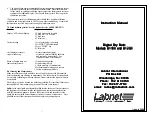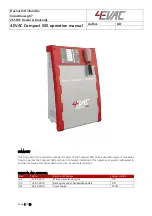
The 7:00-12:00 range controls channel crosstalk in reverb and delay:
•
7:00 — 100% crosstalk; effects are summed to mono regardless of the initial
settings at the input.
•
12:00 — 0% crosstalk; the left and right channels are processed
independently.
When using the delay in ping-pong mode, the STEREO WIDTH knob only
affects channel crosstalk in the 7:00-12:00 range, while the 12:00-5:00 range
has no effect on stereo image width. Set the knob to 12:00 for maximum
width of ping-pong delay.
The STEREO WIDTH knob also controls stereo image width for reverb and
stereo delay. Unlike crosstalk, this parameter is controlled by the full range of
the knob.
Splitting the ranges of the STEREO WIDTH knob was required to allow for
independent left and right channel processing in case of series processing or
double processing.
NB! The STEREO WIDTH knob has an extra function: overall brightness (tone)
control for the wet signal.
In order to set the brightness for the wet signal in
any mode, press and hold the TAP footswitch, then turn the STEREO WIDTH
knob. Set the knob fully CCW to cut out most of the high frequencies. For the
brightest sound with no high cut, set the knob fully CW.
Connection Options
MONO Mode
LEFT IN is the main input. If you are using the pedal with a mono signal source,
use that input exclusively. Connect the signal source to the LEFT IN input, then
connect the LEFT OUT output to the signal receiver.
When in mono mode, the STEREO WIDTH knob changes its functions. It now
slightly changes reverb tone and affects the delay depending on the selected
internal channel setup:
•
Independent channels: the knob introduces barely noticeable drift in delay
time when fully CW (up to 30ms).
•
Ping-pong: in the 7:00-12:00 range, the knob affects the volume of the
second repeat (accent). When set anywhere in the 12:00-5:00 range, the
knob doubles the delay time for all repeats beyond the first one (max delay
time in this mode is 2 seconds).
There is an alternative mono setup variation. Plug the signal source into LEFT
IN, then connect RIGHT OUT to the signal receiver. This way, you will basically
get the same setup as with the standard LEFT IN/LEFT OUT config but with a
difference in the way ping-pong delay works. In the 7:00-12:00 range, the
STEREO WIDTH will now control the volume of the first repeat (accent). With
STEREO WIDTH set anywhere past 12:00, the first repeat will be missing while
delay time will double (max delay time in this mode is 2 seconds). This config
will work well if you need delays longer than 1 second and/or accentuated
repeats.
Using RIGHT IN in mono setups is not recommended.
MONO TO STEREO Mode
In order to convert a mono signal to stereo, connect the signal source to LEFT
IN (the main input jack), then connect LEFT OUT and RIGHT OUT to the signal
receiver. The dry signal will be placed in the center, while the wet signal will be
spread across the stereo image depending on the STEREO WIDTH knob’s
setting (the knob functions normally in this mode).
If you need ping-pong delay with the first repeat happening in the right
channel, reverse the order of the cables coming out of LEFT OUT and RIGHT
OUT.
When a mono signal is plugged into RIGHT IN while LEFT IN is disengaged,
LEFT OUT will only output the sound determined by the STEREO WIDTH knob
(if the knob’s position is past 12:00, LEFT OUT will be silent). The dry signal will
only be heard in the right channel. In ping-pong mode, repeats will be heard
in both channels.
STEREO / DUAL MONO Mode
When both LEFT IN and RIGHT IN are engaged, the pedal goes into dual mono
mode and the channels are processed independently (except for ping-pong
mode in the delay section, where inputs are summed).
The STEREO WIDTH knob works normally. The dry signal in the left channel
goes to LEFT OUT while the dry signal in the right channel goes to RIGHT OUT.
In this mode, you can plug either a stereo source or two mono sources into
the pedal. The two mono sources will be processed together (if the STEREO
WIDTH knob is set past 12:00, there will be no channel crosstalk).
DOUBLE PROCESSING Mode
Aside from standard use cases, independent left & right channel processing
allows using the pedal in mono for double processing. Plug a mono signal
source into LEFT IN, connect RIGHT OUT to the signal receiver, then connect
LEFT OUT to RIGHT IN.
The incoming signal will be processed by the pedal twice. Please note that the
REGEN and STEREO WIDTH knob ranges are significantly altered in this mode.
The pedal goes into self-oscillation much quicker and overloads may happen
at various internal gain stages. However, with a bit of practice you can achieve
very peculiar results in this mode. Experiment away!
The TIME knob and the BEAT switch
The TIME knob sets delay time (in quarter notes) while the BEAT switch allows
you to subdivide it into dotted eighths or quarter note triplets. The TAP LED
displays the set tempo (in quarter notes). When the TIME knob is turned, the
change to delay time is not applied instantly; however, the next delay repeat
will be played at the new tempo. This eliminates artifacts caused by delay time
shifts; at the same time, it allows you to change delay time on the fly and
achieve glitchy effects with the REGEN knob set high. Try playing around with
the BEAT switch while leaving the TIME knob untouched: this way, you will keep
a steady rhythm but get different subdivisions.
The TAP footswitch and the TIME knob have the exact same effect on delay
time. Delay time is determined by the control that has been used last.
Additionally, the TIME knob has a “blind spot”: the first 5% of its range have no
effect on delay time. This allows you to set the knob fully CCW and only use
delay filters without the actual repeats. This way, you can achieve mild
chorus/flanger processing or high-pass filtering (depending on the MODE
switch position).
List of Algorithms
The algorithms are split into two banks; each bank contains three sounds. Use
the MODE switch to select an algorithm from Bank 1. Press and hold the
BYPASS footswitch while using the MODE switch to access the sounds from
Bank 2. When a mode from Bank 1 is selected, the LED glows blue. When a
mode from Bank 2 is selected, the LED glows red.
All the algorithms have been significantly reworked compared to those found
in the Everest M. We have, however, preserved the original character of the
algorithms.
Bank 1 (Blue LED)
MODE
switch position:
•
UP:
Sunshine
A sunny, snowy and frosty morning right atop the Everest. The delay and
reverb in this mode are so bright and cold they will send shivers down your
spine!
•
CENTER:
Eclipse
Modulated delay repeats and solemn reverb reflections make for a perfect
soundscape of the Himalayas at dusk.
•
DOWN:
Moonshine
The initial delay repeats and reverb reflections are accompanied by octave
sounds for a weird, otherworldly effect.
Bank 2 (Red LED)
MODE
switch position (while holding the
BYPASS
footswitch):
•
UP:
Digital
Clean delay repeats with no audible degradation (like the ones in vintage
digital delay machines) coupled with bright reverb reflections make for a
very “transparent” mode.
•
CENTER:
Tape
Modulated tape-style delay with characteristic repeat degradation is
accompanied by dark vintage reverb.
•
DOWN:
Low
A loud lower octave with a long decay is mixed into the reverb reflections.
Together with filtered delay repeats, this creates a powerful low-frequency pad.
Hold Mode (Infinite Sustain)
Press and hold the bypass switch for more than 0.3 seconds to simulate
turning the REGEN knob to the max. In this mode, reverbs become infinite or
very long (2–5 minutes), delays go into maximum feedback, and the LED starts
flashing in various colors. Release the bypass switch to let REGEN go back to
the setting of the knob.
The
Hold Mode
is designed for gradual sound build-up and slow transition into
self-oscillation and saturation. The speed of the build-up depends on the
selected mode and overall brightness settings.
Bypass and Indication
The dry signal path is fully analog throughout the whole pedal. No distortion is
applied to the dry signal. Due to the Everest II’s active bypass, there is no
audible clicking, and three independent global modes are available (selectable
by the
BEAT
switch while holding down the
BYPASS footswitch):
• UP:
“No tails” mode. The effect is only heard when the pedal is engaged in
the signal chain and turns off immediately when the BYPASS footswitch is
pressed.
• CENTER:
“Tails” mode. After you have switched the pedal off via the BYPASS
footswitch, it keeps playing delay repeats and reverb reflections but the
incoming signal is no longer processed.
• DOWN:
“Kill Dry with tails” mode. The dry signal is completely removed from
the output. Just like the previous mode, this one only engages the input
when you press the BYPASS footswitch. The active fragment is played till
the end, so that the sound doesn’t get cut off abruptly. This mode is highly
recommended for Wet-Dry-Wet processing or external wet/dry mixing
setups.
The bypass mode is displayed upon selection and upon power-up. The LED
above the BYPASS footswitch flashes five times in one of the following colors:
• Red:
“No tails” mode.
• Blue:
“Tails” mode.
• White:
“Kill Dry with tails” mode.
BYPASS/HOLD LED
The BYPASS/HOLD LED has five functions:
1. On/off indication. If the pedal is bypassed (disengaged from the signal
chain), the LED doesn’t light up.
2. Algorithm bank indication. If the LED glows blue upon power-up, Bank 1 is
selected; if it glows red, Bank 2 is selected.
3. Hold Mode status indication. When the BYPASS footswitch is held down,
the LED flashes in various colors.
4. “Favorite” status indication. When the Favorite preset is recalled, the
BYPASS/HOLD LED glows green. If the pedal is bypassed but the Favorite
preset is recalled, the LED flashes briefly to indicate that the Favorite
preset will be active when the pedal is turned on.
5. Bypass mode indication upon selection or power-up.
TAP LED
The TAP LED has three functions:
1. Tempo indication. The TAP LED flashes in sync with the current tempo in
quarter notes, not taking the BEAT switch position into account.
2. Delay section setup indication. In independent channels mode, the LED
glows/flashes white. In ping-pong mode, it glows/flashes green.
3. The TAP LED is off when the TIME knob is set fully CCW (meaning that delay
filters are used without the actual repeats).
“Favorite” Preset
In order to store the current settings into a Favorite preset, press and hold
the TAP footswitch and the BYPASS footswitch simultaneously for 3 seconds.
The preset will be recorded into the pedal’s internal memory, and the BYPASS
LED will light up in green.
To recall or exit the Favorite preset, briefly press the BYPASS footswitch
twice. if the BYPASS LED is glowing green, the Favorite preset is active. If the
Favorite preset has been recalled but the pedal is bypassed, the BYPASS LED
lights up briefly: this provides visual feedback regarding the settings which
the pedal will employ when engaged.
To exit the Favorite preset, turn any control knob. This will make the pedal
rescan all the settings on the front panel. There is no bank indication in
Favorite preset mode. All settings (including bypass and delay time settings)
are recorded in the Favorite preset.
Cheat Sheet
TAP LED:
UP Stereo
DOWN Ping-Pong
BEAT
TAP
BEAT
BYPASS
BYPASS LED:
UP: NO TAILS
CENTER: TAILS
DOWN: KILL DRY
BYPASS
TAP
BYPASS LED:
STEREO WIDTH
TAP
Stereo Delay Setup
Bypass Type Setup
Bank Select
Brightness
Favorite
MODE
BYPASS
BYPASS LED:
BANK 1
BANK 2
Specifications
• LEFT IN / RIGHT IN:
6.3mm, mono, unbalanced, 1MOhm input impedance.
LEFT IN is the main mono input.
• LEFT OUT / RIGHT OUT:
6.3mm, mono, unbalanced, 100 Ohm output
impedance. LEFT OUT is the main mono output.
• EXT. TAP:
6.3mm, normally open momentary button.
• Max delay time:
1 second (2 seconds in ping-pong mode in a mono setup).
• Power:
2,1/5,5mm, negative tip. The pedal can’t be powered by battery. Use
a regulated PSU only.
•
9V DC 100mA.
•
12V DC 75mA.
• Dimensions (LхWхH):
110х104х56mm (4.3x4.1x2.2”).
• Weight:
350g (0.77lbs).
www.shift-line.com/
everest2






















